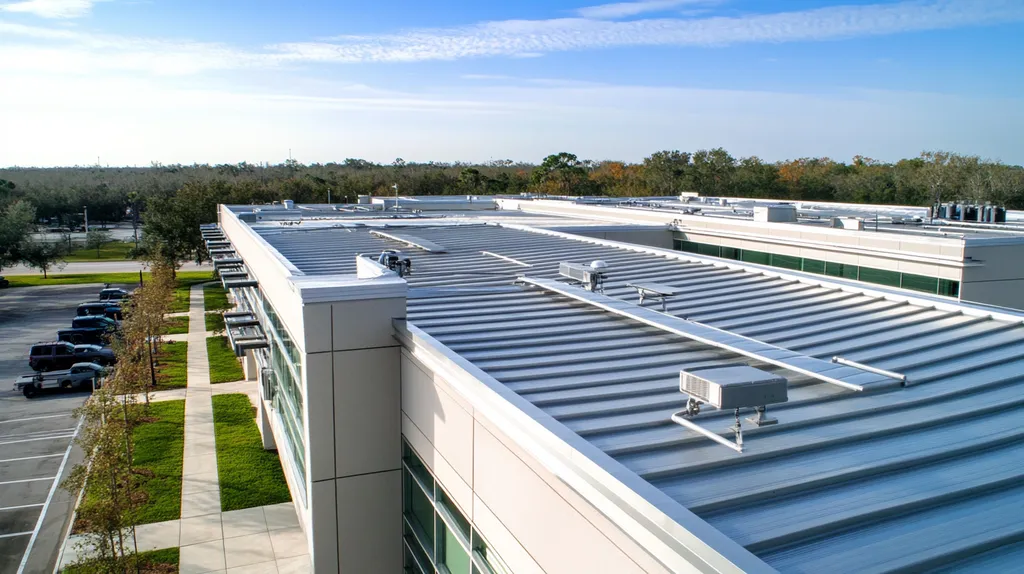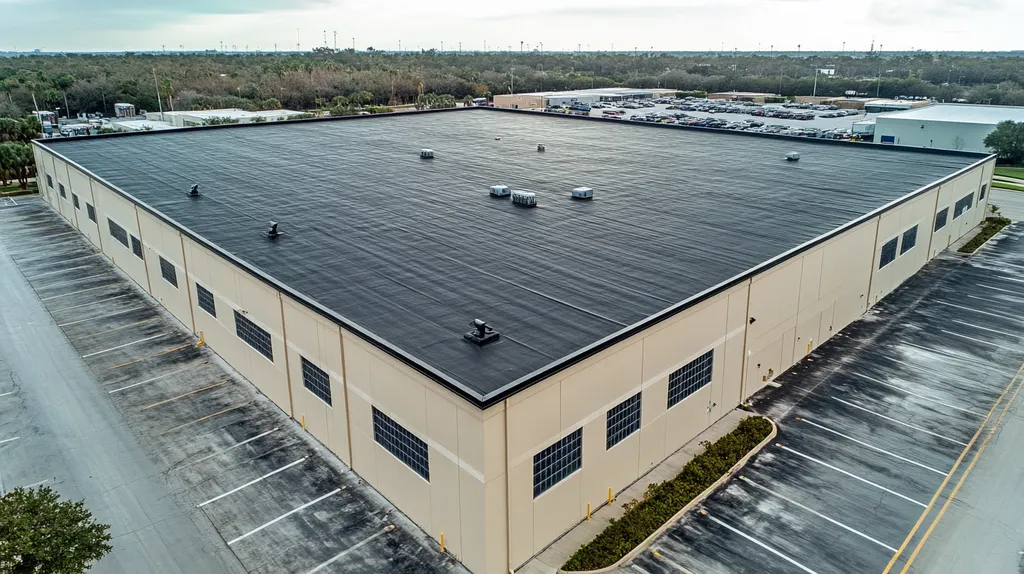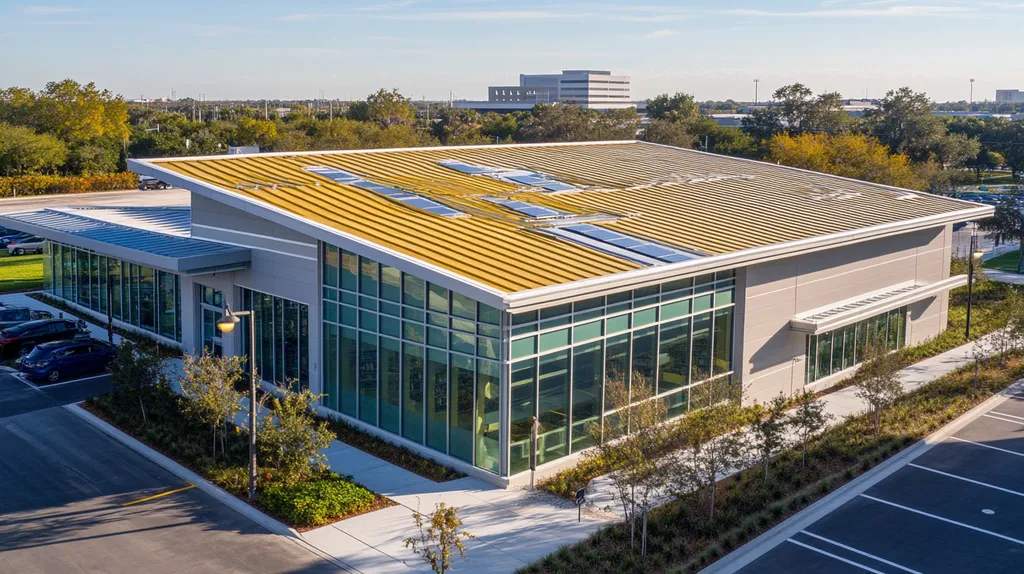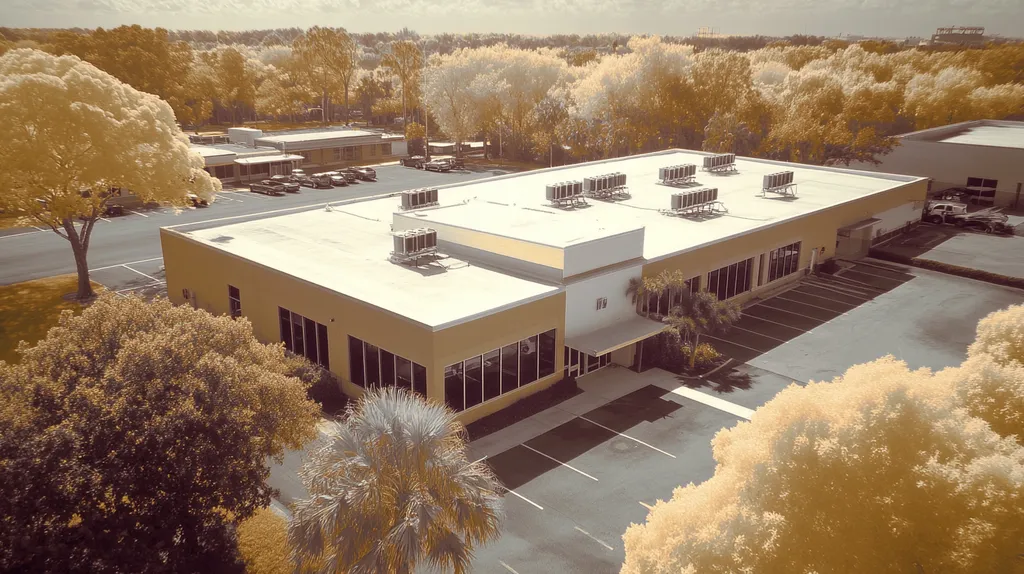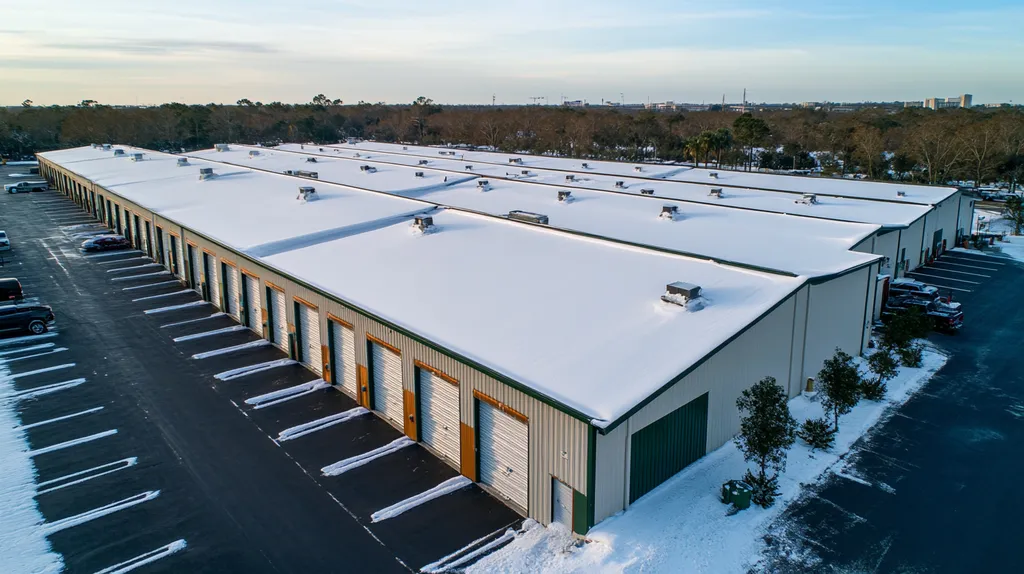Commercial roof coating failures cost property owners between $15,000 and $180,000 in emergency repairs—yet most failures stem from preventable decisions made during the selection and application process.
The difference between a coating that protects for 5 years versus 20 years depends on understanding critical factors that facility managers consistently overlook.
Material chemistry, surface preparation, environmental stresses, and application timing create a complex performance matrix where shortcuts in one area inevitably compromise long-term protection.
This guide examines the technical and practical factors that determine coating longevity, helping property managers make informed decisions that maximize their roofing investments.
SECTION 1: THE BASICS EXPLAINED
Commercial roof failures cost property owners an average of $15,000 to $25,000 per incident—and that’s before factoring in business disruption or inventory damage. The difference between a coating that lasts 5 years versus 15 years can determine whether a facility maintains profitability or faces unexpected capital expenditures.
Yet many property managers make coating decisions based on upfront cost alone, overlooking the critical factors that determine long-term performance. Understanding what roof coatings actually do, their impact on building operations, and the science behind their protection reveals why this approach often backfires.
What It Is (In Plain Language)
A roof coating functions as a liquid-applied shield that transforms into a seamless protective membrane once cured. This barrier covers the entire roof surface, eliminating the weak points that plague traditional roofing systems—the seams, joints, and penetrations where most leaks originate.
The three primary coating families each serve different purposes. Acrylic coatings excel at UV reflection and breathability, making them ideal for moderate climates.
Silicone coatings resist ponding water and maintain flexibility in extreme temperatures. Polyurethane coatings offer superior impact resistance and adhesion to challenging surfaces like metal.
Unlike tear-off replacements that can shut down operations for weeks, coating applications typically allow buildings to remain functional. The process involves cleaning, minor repairs, and application—usually completed in days rather than months.
This approach preserves the existing roof structure while adding 10 to 20 years of service life. The coating essentially resets the roof’s aging clock without the massive expense and disruption of full replacement.
Why It Matters (To Your Building)
Energy costs represent up to 30% of a commercial building’s operating expenses, with HVAC systems working hardest during peak cooling months. Reflective roof coatings can reduce surface temperatures from 180°F to under 90°F, directly translating to lower utility bills and reduced equipment strain.
The waterproofing benefits extend far beyond preventing obvious leaks. Even minor moisture intrusion can trigger mold growth, insulation degradation, and structural damage that multiplies repair costs exponentially.
Timing matters critically in coating decisions. Applied to a roof showing early signs of wear, coatings can extend service life by 15-20 years, depending on coating type and environmental conditions.
Wait until major deterioration occurs, and the same coating investment may only provide 5-7 years of protection. This timing difference can represent hundreds of thousands in avoided replacement costs for large facilities.
Coating lifespans vary significantly by type, with silicone systems lasting 15-20 years and acrylics providing 10-15 years of protection when properly applied (source: South Chicago Insulation).
How It Works
The protective mechanism begins at the molecular level, where coating polymers form chemical bonds with the existing roof surface. This creates a monolithic membrane that moves as one unit, preventing the differential expansion that causes traditional roofing failures.
UV degradation—the primary aging factor for most roofing materials—gets blocked by reflective pigments and UV-stable resins. This prevents the brittleness and cracking that typically develop after 10-15 years of sun exposure.
Temperature cycling, which causes roofing materials to expand and contract daily, gets managed through the coating’s engineered flexibility. Quality systems can accommodate building movement without developing stress cracks or losing adhesion.
The breathability factor distinguishes professional-grade coatings from simple paints. Moisture vapor can escape upward through the coating while liquid water gets blocked from penetrating downward.
This vapor permeability prevents trapped moisture problems that can destroy insulation and structural decking. The coating essentially creates a one-way moisture barrier that protects the building while allowing the roof system to dry naturally.
SECTION 2: PRACTICAL APPLICATIONS
Manufacturing facilities with aging metal roofs face a stark choice: spend $300,000 on full replacement or invest $75,000 in strategic coating applications. Yet facility managers often delay coating decisions until emergency repairs force their hand—when coating options become limited and costs multiply.
The window for maximum coating effectiveness is narrower than most property owners realize. Understanding where coatings deliver the greatest value, recognizing critical timing indicators, and ensuring system compatibility can mean the difference between a 20-year asset extension and a costly maintenance mistake.
Common Uses & Examples
Metal roofing systems represent the most successful coating applications, where silicone and acrylic systems routinely extend service life by 15-20 years. Food processing plants particularly benefit from this approach, as coatings eliminate the rust formation and thermal movement that plague exposed metal surfaces.
Modified bitumen roofs in retail and office buildings see dramatic improvements when coated before membrane cracking becomes widespread. The coating bridges minor surface defects while providing the reflective properties that can reduce HVAC loads by 15-25%.
Industrial facilities handling chemicals rely on specialized polyurethane coatings to resist oil penetration and solvent damage that would destroy standard roofing materials. These applications often justify their higher initial cost through extended equipment life and reduced contamination cleanup.
Concrete roofs on parking structures and institutional buildings benefit from elastomeric coatings that accommodate structural movement while preventing water intrusion. The coating fills hairline cracks that would otherwise expand through freeze-thaw cycles.
When You Need It Most
The optimal coating window occurs when roofs show initial weathering signs but retain structural integrity—typically at the 10-15 year mark for most commercial systems. At this stage, coatings can reset the aging process and deliver maximum service life extension.
Post-storm applications represent critical intervention opportunities, where prompt coating can prevent minor hail damage from developing into major leak sources. Insurance settlements often cover these preventive measures more readily than emergency repairs.
Budget-constrained facilities facing capital expenditure limits find coatings essential for maintaining building envelope integrity. A well-timed coating application can defer replacement costs by a decade while preserving warranty coverage on building systems.
Commercial roof coatings typically last between 10 to 20 years, with silicone systems providing 15-20 years of protection and acrylics delivering 10-15 years when properly applied to suitable substrates (source: South Chicago Insulation).
Interactions With Other Systems
Drainage compatibility determines coating success more than any other factor, as ponding water can cause premature coating failure within 2-3 years. Facilities must address slope deficiencies before coating application to prevent moisture entrapment and membrane degradation.
HVAC equipment placement requires careful coating selection, as foot traffic and maintenance activities can damage softer coating systems. High-traffic areas benefit from polyurethane coatings that resist impact damage and maintain adhesion under mechanical stress.
Insulation systems beneath the roof deck influence vapor permeability requirements, with impermeable barriers requiring breathable coatings to prevent moisture buildup. Mismatched systems can trap condensation and accelerate structural decay.
Solar panel installations demand coatings that maintain flexibility under concentrated heat loads while providing secure mounting surfaces. The coating must accommodate thermal expansion without compromising attachment point integrity or electrical safety requirements.
SECTION 3: KEY TERMINOLOGY DECODED
A single misunderstood specification can transform a $50,000 coating investment into a $200,000 replacement project within five years. Yet facility managers routinely approve coating proposals without grasping critical terms like adhesion strength, dry film thickness, or substrate compatibility.
Industry terminology confusion leads to coating failures that could have been prevented through proper specification understanding. When contractors reference “20-mil DFT” or “350 psi adhesion,” these aren’t just technical details—they’re the difference between a coating that lasts two decades versus one that fails in the first severe weather event.
Essential Terms Explained
Adhesion strength determines whether a coating system survives its first major storm or peels away in sheets during high winds. Measured in pounds per square inch (psi), adhesion ratings above 200 psi indicate professional-grade performance, while anything below 150 psi signals potential failure under stress.
Adhesion becomes absolutely critical for ensuring a roof coating’s longevity and effectiveness, as molecular bonding with the substrate provides the foundation for all other performance characteristics. Without proper adhesion, even the most advanced coating chemistry becomes worthless against weather exposure.
Elastomeric properties allow coatings to stretch up to 300% of their original size without cracking—essential for accommodating the daily thermal expansion that can reach several inches across large roof surfaces. This flexibility prevents the stress fractures that create leak pathways in rigid coating systems.
Solar reflectance index (SRI) combines a coating’s ability to reject heat with its capacity to release absorbed energy back to the atmosphere. SRI values range from 0 to 100, with higher numbers indicating superior heat management that can reduce surface temperatures by up to 50°F.
Industry Jargon Translated
Dry Film Thickness (DFT) represents the final cured coating thickness after water and solvents evaporate—typically 40-60% of the original wet application thickness. A 20-mil DFT coating provides the minimum thickness for 10-year performance, while 30-40 mils can extend service life to 15-20 years.
Under-applied coatings fail prematurely because insufficient thickness cannot withstand UV degradation and thermal cycling. Over-application wastes material and can create adhesion problems as thick films cure unevenly and develop internal stresses.
Volatile Organic Compounds (VOC) content affects both environmental compliance and application conditions, with low-VOC formulations requiring longer cure times but offering safer working environments. High-VOC products cure faster but face increasing regulatory restrictions in many regions.
Pot life defines how long mixed coating materials remain usable after catalyst addition—critical for scheduling application crews and managing material waste. Exceeded pot life results in coating that won’t cure properly, creating soft spots vulnerable to damage.
Measurement & Units Simplified
Mil thickness measurements—where one mil equals 1/1000th of an inch—determine coating durability more than any other specification. A human hair measures about 2-3 mils, making a 20-mil coating roughly seven times thicker than hair.
Coverage rates typically range from 50-100 square feet per gallon depending on application thickness and substrate porosity. Porous surfaces like concrete require additional material for proper sealing, while smooth metal surfaces achieve maximum coverage rates.
Cure time specifications include both tack-free time (when the surface can be lightly touched) and full cure (when the coating reaches maximum performance properties). Different coating types resist ponding water but can become brittle in freeze-thaw climates, making cure time critical for weather exposure timing (source: Castagra).
Temperature and humidity ranges during application directly affect cure times and final coating properties. Most systems require minimum 45°F temperatures and specific humidity levels to achieve rated performance characteristics.
SECTION 4: DECISION FACTORS
A warehouse operator recently discovered that choosing the cheapest coating option cost them $180,000 in premature replacement after just four years—triple their initial investment. The decision factors that determine coating success extend far beyond upfront pricing, encompassing performance capabilities that directly impact operational continuity and long-term asset protection.
Quality materials, proper installation, weather resilience, and maintenance requirements create a complex decision matrix where shortcuts in one area inevitably compromise others. Understanding these interconnected factors prevents costly mismatches between coating capabilities and facility demands.
Cost Considerations
Material costs typically represent only 40% of total project expenses, with labor, preparation, and downtime comprising the majority of coating investment. Premium coatings that require fewer application coats can actually reduce total installation costs while delivering superior protection.
Life-cycle analysis reveals that coatings priced 30% higher upfront often provide 50-75% longer service life, dramatically improving cost per year of protection. This calculation becomes critical for facilities operating on tight maintenance budgets or facing deferred capital expenditures.
Energy savings from reflective coatings can offset initial cost premiums within 2-3 years through reduced HVAC loads. Buildings in hot climates see the greatest return, with cooling cost reductions of 15-25% commonly reported after coating applications.
Warranty coverage varies significantly between manufacturers, with some offering 10-year material warranties while others provide comprehensive system guarantees including labor costs. These warranty differences can represent substantial risk transfer that justifies higher initial investments.
Hidden costs emerge when coatings fail prematurely, requiring emergency repairs during peak business periods. The combination of expedited contractor rates, lost productivity, and potential inventory damage can exceed the original coating investment by 200-300%.
Performance Trade-offs
UV resistance determines coating longevity in sun-exposed applications, with silicone systems maintaining flexibility after 15+ years while lower-grade acrylics may become brittle within 7-10 years. This durability difference becomes pronounced in southern climates where roof surface temperatures exceed 160°F regularly.
Adhesion strength creates the foundation for all other performance characteristics, yet improving adhesion often requires longer cure times or more complex surface preparation. Facilities with tight maintenance windows must balance these requirements against operational constraints.
Chemical resistance varies dramatically between coating types, with polyurethane systems excelling in industrial environments while acrylics may degrade when exposed to oils or solvents. Manufacturing facilities must prioritize chemical compatibility over other performance factors to prevent premature coating failure.
Impact resistance becomes critical for roofs with regular maintenance traffic or hail exposure, but thicker, more durable coatings typically cost 25-40% more than standard formulations. The investment proves worthwhile for facilities in severe weather zones or those with extensive rooftop equipment.
Breathability affects moisture management in existing roof systems, with vapor-permeable coatings preventing trapped moisture problems that can destroy insulation and structural components. Non-breathable coatings may offer superior waterproofing but risk creating condensation issues in certain climates.
Lifespan & Durability Factors
Substrate preparation influences coating lifespan more than material quality, with properly cleaned and primed surfaces extending service life by 40-60% compared to minimal preparation approaches. Power washing, rust treatment, and seam sealing create the foundation for long-term coating adhesion.
Weather conditions during application affect final coating properties permanently, with temperature and humidity variations altering cure rates and film formation. Coatings applied outside manufacturer specifications may appear successful initially but fail prematurely under stress.
Quality materials, proper installation processes, extreme weather exposure, and routine maintenance practices significantly impact coating durability and long-term performance. These factors work together to determine whether coatings achieve their rated service life or require premature replacement.
Ponding water represents the most common cause of coating failure, with even minor drainage issues reducing lifespan from 15-20 years to 5-7 years. Addressing slope deficiencies before coating application prevents moisture entrapment that accelerates membrane degradation.
Maintenance frequency directly correlates with coating longevity, as annual inspections and minor repairs can extend service life by 25-30% compared to neglected systems (source: Kangaroo Roof). Simple tasks like debris removal and drain cleaning prevent the damage accumulation that leads to major coating failures.
SECTION 5: COMMON CHALLENGES
A facility manager recently watched $85,000 worth of coating peel away in sheets during a moderate windstorm—just eighteen months after application. The failure traced back to three preventable issues: inadequate surface preparation, poor timing decisions, and ignored drainage problems.
Industry data reveals that 60% of premature coating failures stem from these same recurring challenges that facility managers consistently underestimate. Understanding these failure patterns, recognizing early warning indicators, and implementing systematic prevention strategies can mean the difference between a coating system that lasts two decades versus one that fails within five years.
Frequent Problems & Solutions
Surface contamination causes more coating failures than any other factor, with oil residues, oxidation, and moisture preventing proper molecular bonding. Even microscopic contamination layers can reduce adhesion strength by 70%, leading to catastrophic peeling during thermal cycling.
The solution requires aggressive surface preparation including degreasing, power washing, and complete drying before application. Facilities must schedule sufficient preparation time—typically 2-3 days for thorough cleaning and moisture removal.
Application thickness inconsistencies create weak spots where premature wear concentrates, often resulting from untrained applicators or inadequate equipment calibration. Thin spots fail first, allowing water penetration that accelerates adjacent coating degradation.
Professional contractors use mil gauges and systematic application patterns to ensure uniform coverage within manufacturer specifications. This attention to detail typically adds 15-20% to application costs but prevents failures that cost 300-400% of the original investment.
Drainage deficiencies trap moisture against coating surfaces, creating hydrostatic pressure that breaks adhesive bonds within 2-3 years. Ponding water also concentrates UV degradation and supports biological growth that attacks coating chemistry.
Addressing slope issues before coating application prevents these moisture problems, even if it requires additional tapered insulation or structural modifications. The investment in proper drainage extends coating life from 7-10 years to the full 15-20 year potential.
Warning Signs To Watch For
Adhesion loss typically appears as edge lifting or bubble formation around roof penetrations and perimeter areas. These initial failures create entry points for moisture that rapidly expands the affected area during freeze-thaw cycles.
Facility managers should inspect these vulnerable areas quarterly, especially after severe weather events. Early intervention with localized repairs can prevent minor adhesion issues from becoming system-wide failures.
Color changes or chalking indicate UV degradation that compromises coating flexibility and waterproofing properties. Silicone coatings resist ponding water but can become brittle over time, particularly in climates with repeated freeze-thaw cycles (source: Castagra).
Surface cracking follows predictable patterns, typically starting at stress concentration points like equipment supports or expansion joints. These cracks propagate rapidly once initiated, requiring immediate attention to prevent water infiltration.
Energy performance changes signal coating degradation even when visual inspection shows minor wear. Increasing cooling costs or interior temperature fluctuations indicate loss of reflective properties that may not be visually apparent.
Monitoring utility bills provides early warning of coating performance decline, allowing proactive maintenance before complete system failure occurs. This data-driven approach prevents emergency situations that force expensive rushed solutions.
Preventative Approaches
Scheduled maintenance programs identify minor issues before they compromise system integrity, with semi-annual inspections providing optimal cost-to-benefit ratios. These inspections focus on drainage function, coating adhesion, and surface condition changes.
Documentation of inspection findings creates performance baselines that reveal degradation trends over time. This historical data supports informed decisions about repair timing and helps optimize maintenance budgets.
Material selection based on specific environmental stresses prevents mismatched systems that fail prematurely under local conditions. Facilities in high-UV environments require different coating chemistry than those facing chemical exposure or extreme temperature cycling.
Working with coating manufacturers during selection ensures compatibility with existing roof systems and expected service conditions. This collaboration often reveals application requirements that prevent common installation mistakes.
Contractor qualification standards eliminate the application errors that cause most coating failures, with experienced applicators following systematic preparation and installation protocols. Properly applied coatings routinely achieve their rated service life while poorly installed systems fail within half their expected lifespan.
Quality control during application includes thickness verification, cure time monitoring, and weather condition compliance. These additional oversight measures add minimal cost while dramatically improving long-term coating performance and reliability.
SECTION 6: NEXT STEPS & RESOURCES
A manufacturing facility recently saved $200,000 in replacement costs by asking their contractor one critical question about molecular bonding strength—a specification detail that distinguished professional-grade coating from standard products. Yet 70% of facility managers approve coating projects without understanding the essential questions that separate successful applications from costly failures.
The gap between coating success and failure often comes down to three factors: asking the right questions during contractor selection, following established industry protocols, and maintaining current knowledge of coating advances. These resources provide the framework for making informed decisions that protect both immediate investments and long-term asset value.
Questions To Ask Providers
Substrate compatibility represents the most critical technical question, as mismatched coating chemistry can reduce adhesion by 60% regardless of application quality. Ask contractors to explain their assessment process for existing roof conditions and how they determine optimal coating selection for your specific substrate.
Surface preparation protocols separate professional contractors from those who cut corners to reduce costs. Request detailed explanations of cleaning procedures, moisture testing methods, and primer application requirements—these preparation steps determine whether coatings achieve their rated 15-20 year lifespan.
Weather monitoring procedures during application affect final coating properties permanently, with temperature and humidity variations altering cure rates and film formation. Contractors should demonstrate systematic weather tracking and explain contingency plans for changing conditions.
Warranty coverage varies dramatically between providers, with some offering material-only protection while others guarantee complete system performance including labor costs. Clarify warranty terms, inspection requirements, and the specific conditions that could void coverage to avoid unexpected repair expenses.
Quality control measures during application include thickness verification, adhesion testing, and cure monitoring that ensure coating systems meet manufacturer specifications. Ask to see sample inspection reports and understand how contractors document compliance with technical requirements.
Adhesion strength becomes absolutely critical for ensuring coating longevity and effectiveness, with molecular bonding providing the foundation for all other performance characteristics (source: Castagra). Request specific adhesion strength ratings and ask how contractors verify these values achieve proper substrate bonding.
Industry Standards & Guidelines
ASTM International publishes the technical standards that define proper coating application, surface preparation, and performance testing methods used throughout the commercial roofing industry. These specifications provide measurable criteria for evaluating contractor proposals and ensuring applications meet professional standards.
The National Roofing Contractors Association (NRCA) maintains comprehensive guidelines covering coating selection, installation procedures, and maintenance protocols that facility managers can use to verify contractor recommendations. These resources translate technical requirements into practical application guidance.
Manufacturer technical bulletins supplement industry standards with product-specific requirements that often exceed minimum code compliance. These documents address application temperature ranges, substrate compatibility, and cure time specifications that directly affect coating performance.
Local building codes increasingly incorporate energy efficiency requirements that influence coating selection, particularly regarding solar reflectance values and thermal performance standards. Understanding these regulations ensures coating investments support both building protection and compliance objectives.
Third-party testing organizations like UL and FM Global provide independent verification of coating performance claims, offering facility managers objective data for comparing product capabilities. These certifications validate manufacturer specifications and reduce the risk of performance disappointments.
Further Learning Simplified
Professional development programs through organizations like the RCI (Roof Consultants Institute) offer facility managers structured learning opportunities that translate directly to improved decision-making capabilities. These certification courses focus on practical knowledge rather than theoretical concepts.
Industry publications including Professional Roofing Magazine and Roofing Contractor provide monthly insights into coating technology advances, case studies, and market trends that keep facility managers current with evolving best practices. Subscription content often includes technical guides and specification updates.
Manufacturer technical seminars deliver product-specific training that helps facility managers understand new coating technologies and application techniques. These sessions typically include hands-on demonstrations and real-world case studies relevant to commercial applications.
Regional roofing associations host networking events where facility managers can learn from peers facing similar challenges and share successful coating strategies. These connections often provide valuable insights into local contractor performance and emerging maintenance approaches.
Continuing education through webinars and online training modules allows busy facility managers to stay informed without travel requirements or extended time commitments. Many programs offer certificates that demonstrate professional development to senior management and support career advancement.
The Bottom Line
Commercial roof coating failures averaging $75,000 in emergency repairs are entirely preventable when facility managers understand the critical factors that determine system longevity.
Material chemistry, surface preparation quality, environmental compatibility, and application timing create the performance foundation that separates 20-year coating success from 5-year costly failures.
The window for optimal coating application is narrower than most property owners realize—waiting until visible damage appears cuts potential service life in half while doubling long-term costs.
Industry data confirms that facilities implementing systematic coating evaluation, professional installation oversight, and proactive maintenance programs achieve rated service life performance while reducing total roof lifecycle costs by 40-60%.
With coating technology advances and proven application protocols now available, the difference between coating success and failure depends entirely on informed decision-making during the critical selection and implementation phases.
FREQUENTLY ASKED QUESTIONS
Q. What basic factors affect the longevity of a commercial roof coating?
A. Longevity depends on coating type, proper surface preparation, and timely application before major roof deterioration occurs. Reflective properties reduce thermal stress, while flexibility helps manage expansion and contraction. Early application can extend roof life by up to 20 years, preventing costly repairs and disruptions.
Q. When is the best time to apply coatings on an industrial roof?
A. The ideal window is when the roof shows signs of wear but remains structurally sound, usually after 10-15 years. Prompt application after storm damage or before major membrane cracking ensures longer service life, better cost savings, and maintains warranty coverage. Delays often halve protection duration and increase repair expenses.
Q. What key terms should commercial roof managers understand before coating?
A. Crucial terms include adhesion strength, dry film thickness, and elastomeric properties. High adhesion prevents peeling, proper thickness ensures durability, and elastomeric flexibility resists cracking from thermal movement. Understanding these terms helps specify coatings that withstand weather and perform reliably over time.
Q. What decision factors most impact the success of a commercial roof coating?
A. Success hinges on quality materials, thorough surface preparation, weather conditions during application, and maintenance plans. Cost should factor in life-cycle value, not just upfront price. Ignoring drainage or substrate compatibility often leads to premature failures, negating initial savings.
Q. What common challenges cause industrial roof coating failures?
A. Main issues include insufficient surface cleaning, inconsistent coating thickness, poor timing, and unresolved drainage problems. These lead to adhesion loss, peeling, and rapid degradation. Regular inspections and proper contractor protocols prevent these avoidable failures, protecting investment longevity.
Q. What questions should I ask contractors before coating my commercial roof?
A. Inquire about their surface assessment methods, compatibility testing, and preparation protocols. Request details on weather monitoring, warranty terms including labor coverage, and quality control practices like adhesion testing. Clear answers ensure professional standards and long-lasting results.
Q. How do maintenance and inspections extend a commercial roof coating’s lifespan?
A. Regular inspections identify early issues like ponding water, adhesion loss, or surface damage before escalation. Routine cleaning and minor repairs prevent moisture buildup and UV degradation. Proactive maintenance can increase coating life by up to 30%, reducing unexpected repair costs and prolonging roof performance.

